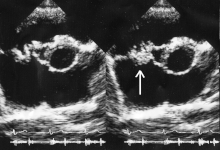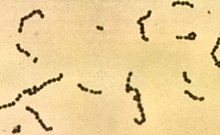Subacute bacterial endocarditis
| Subacute bacterial endocarditis | |
|---|---|
| Other names | Endocarditis lenta |
 | |
| Vegetation of tricuspid valve by ECHO | |
| Specialty | Cardiology |
| Symptoms | Malaise, weakness[1] |
| Causes | Streptococcus mutans, mitis, sanguis or milleri bacteria[2][3] |
| Diagnostic method | Blood culture specimens over 24-hour period/analysis[4] |
| Treatment | Intravenous penicillin[2] |
Subacute bacterial endocarditis, abbreviated SBE, is a type of endocarditis (more specifically, infective endocarditis).[5] Subacute bacterial endocarditis can be considered a form of type III hypersensitivity.[6]
Signs and symptoms
Among the signs of subacute bacterial endocarditis are:[1]
Causes

It is usually caused by a form of Viridans group streptococcus bacteria that normally live in the mouth[3] (Streptococcus mutans, mitis, sanguis or milleri).[2]
Other strains of streptococci can cause subacute endocarditis as well. These include streptococcus intermedius, which can cause acute or subacute infection (about 15% of cases pertaining to infective endocarditis).[7]
Mechanism
The mechanism of subacute bacterial endocarditis could be due to malformed stenotic valves which in the company of bacteremia, become infected, via adhesion and subsequent colonization of the surface area. This causes an inflammatory response, with recruitment of matrix metalloproteinases, and destruction of collagen.[8]
Underlying structural
Diagnosis
Subacute bacterial endocarditis can be diagnosed by collecting three blood culture specimens over a 24-hour period for analysis,[4] also it can usually be indicated by the existence of:
Treatment

The standard treatment is with a minimum of four weeks of high-dose intravenous penicillin with an aminoglycoside such as gentamicin. The use of high-dose antibiotics is largely based upon animal models.[2]
Leo Loewe of Brooklyn Jewish Hospital was the first to successfully treat subacute bacterial endocarditis with penicillin. Loewe reported at the time seven cases of subacute bacterial endocarditis in 1944.[14]
See also
References
- ^ ISBN 9781468439205.
- ^ PMID 16549513.
- ^ ISBN 9780323293211.
- ^ ISBN 9780781797016.
- ^ a b "Infective Endocarditis. Information; prevention of endocarditis | Patient". Patient. Retrieved 2015-08-28.
- ISBN 9781134428021.
- ^ "Endocarditis". The Lecturio Medical Concept Library. Retrieved 18 July 2021.
- ^ Pathology of Infectious Endocarditis at eMedicine
- ISBN 9781449605940.
- ISBN 9780323293174.
- ISBN 9780781770439.
- ISBN 9781608314645.
- ^ Clubbing of the Nails~clinical at eMedicine
- PMID 19312479.
Further references
- Goolsby, Mary Jo; Grubbs, Laurie (2011-04-28). Advanced Assessment: Interpreting Findings and Formulating Differential Diagnoses. F.A. Davis. ISBN 9780803625174.
- Silverman, Sol; Eversole, Lewis R.; Truelove, Edmond L. (2002-01-01). Essentials of Oral Medicine. PMPH-USA. ISBN 9781550091465.
- Kiefer, TL; Bashore, TM (2012). "Infective endocarditis: a comprehensive overview". Reviews in Cardiovascular Medicine. 13 (2–3): e105–20. PMID 23160159.
